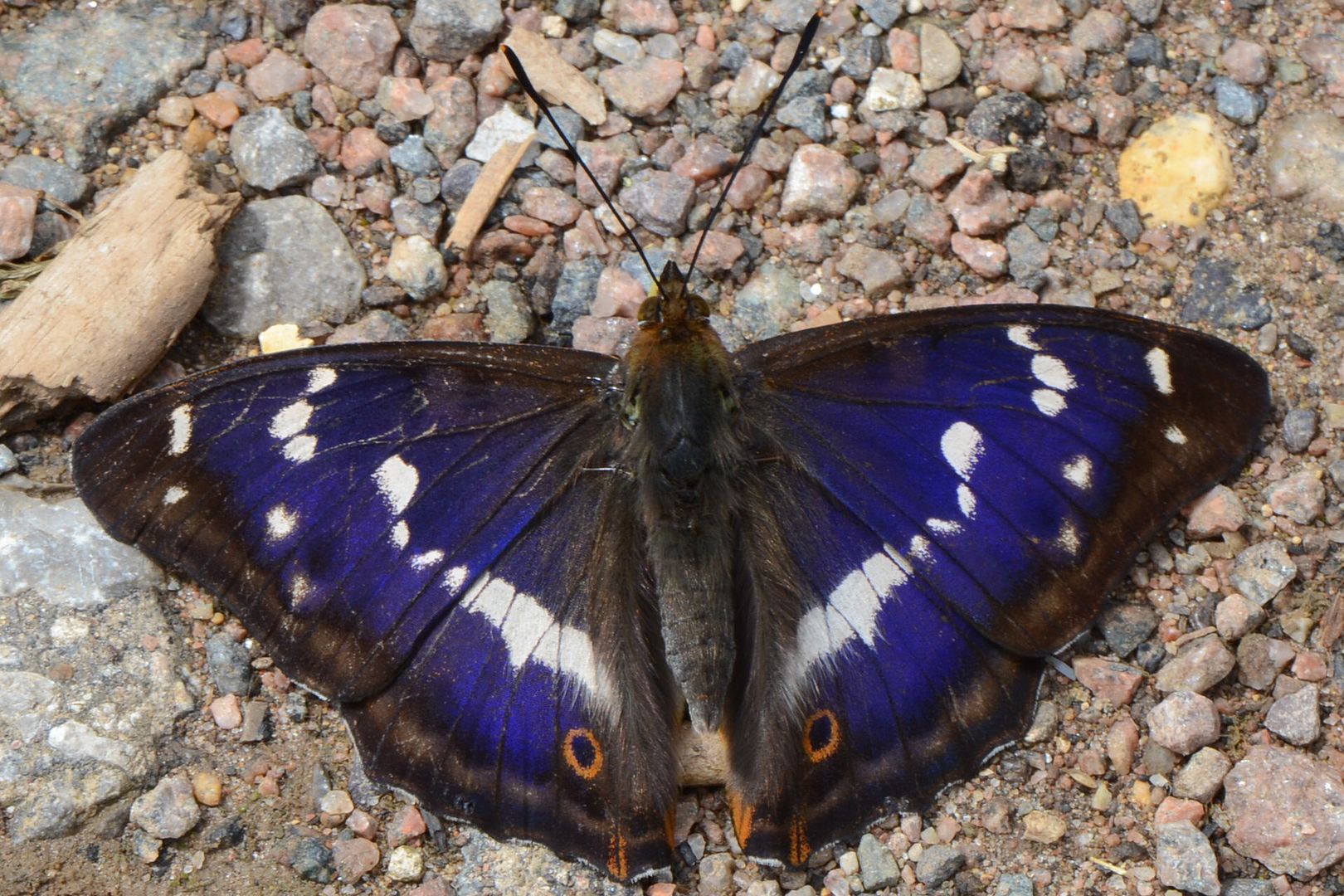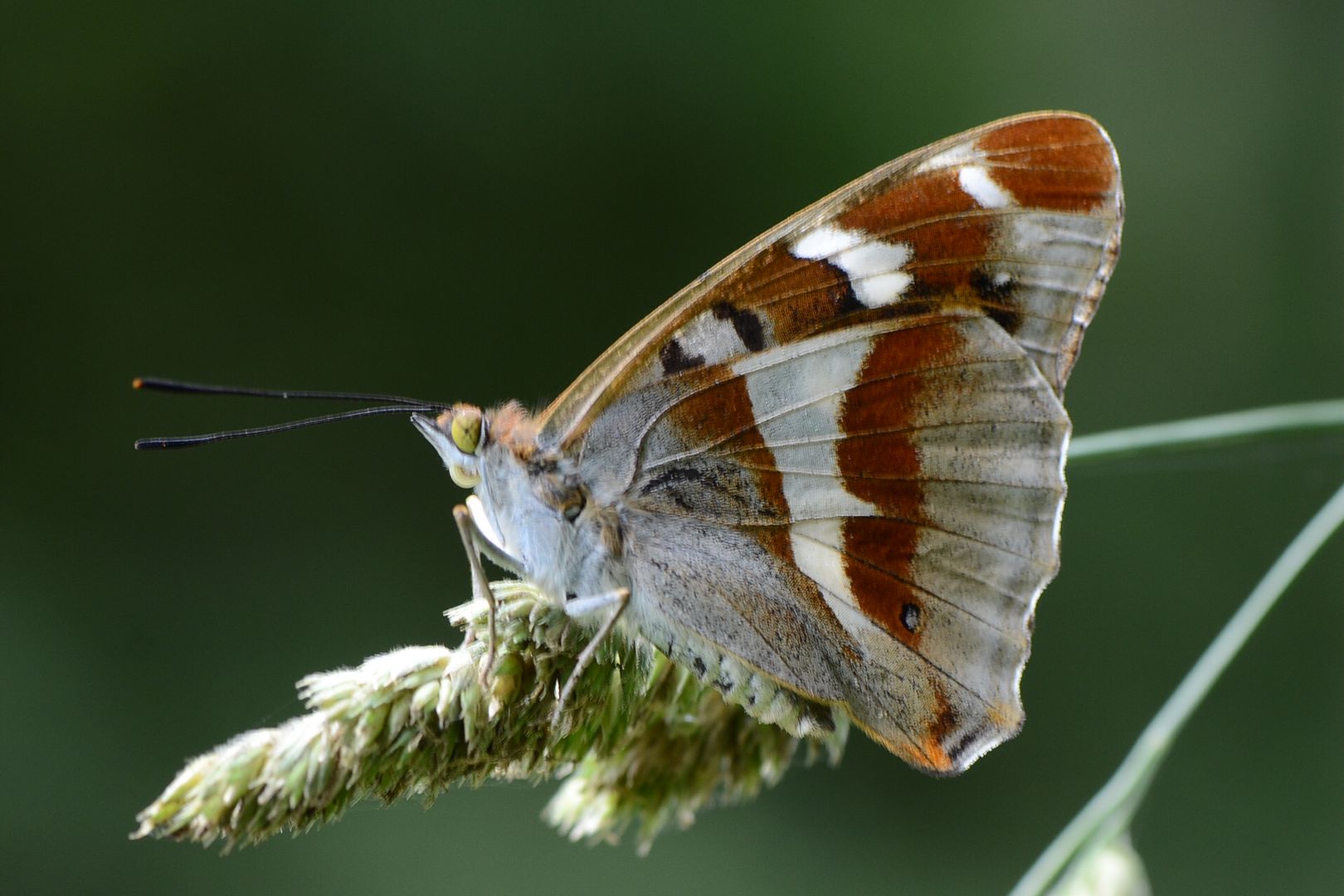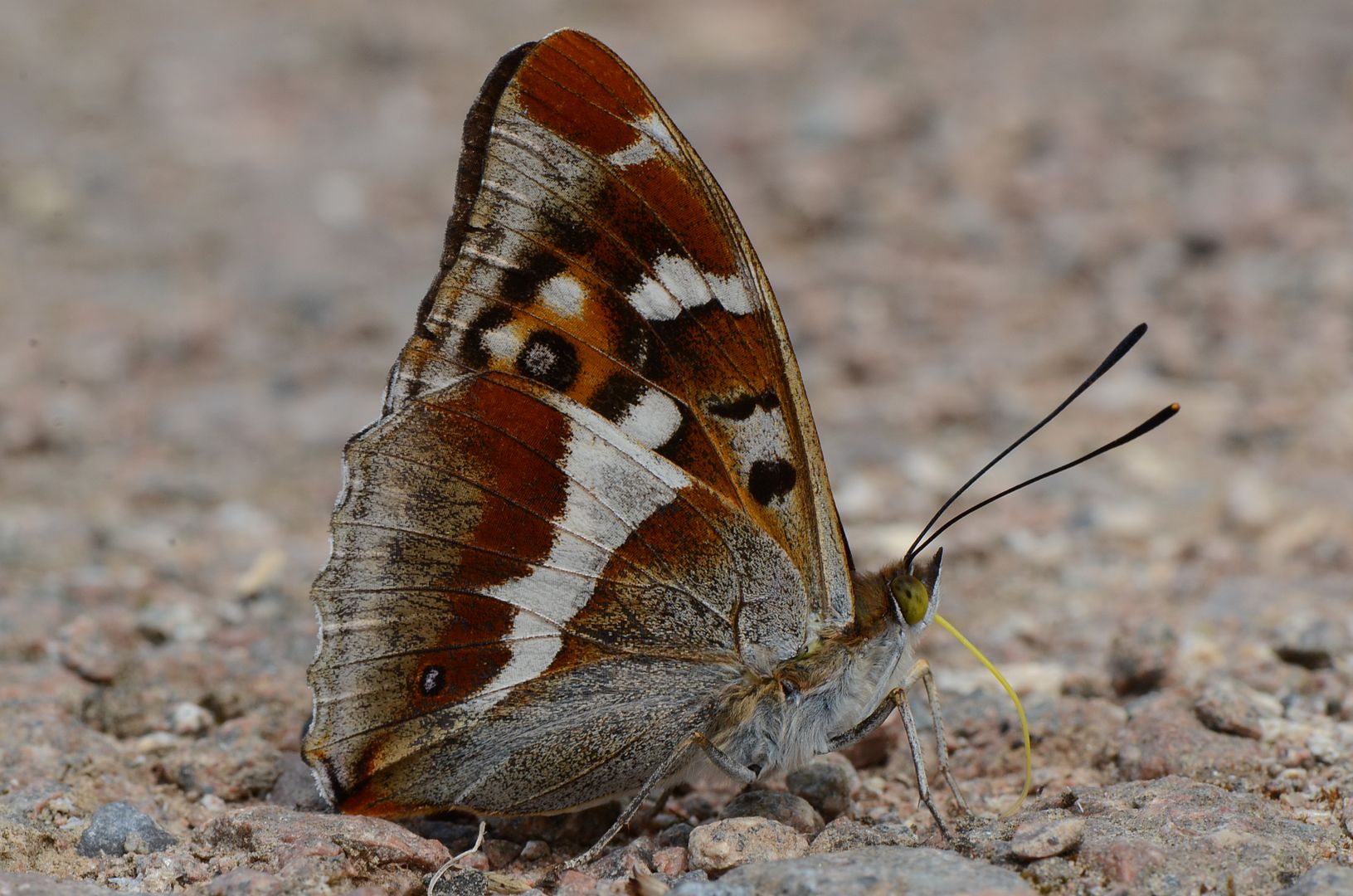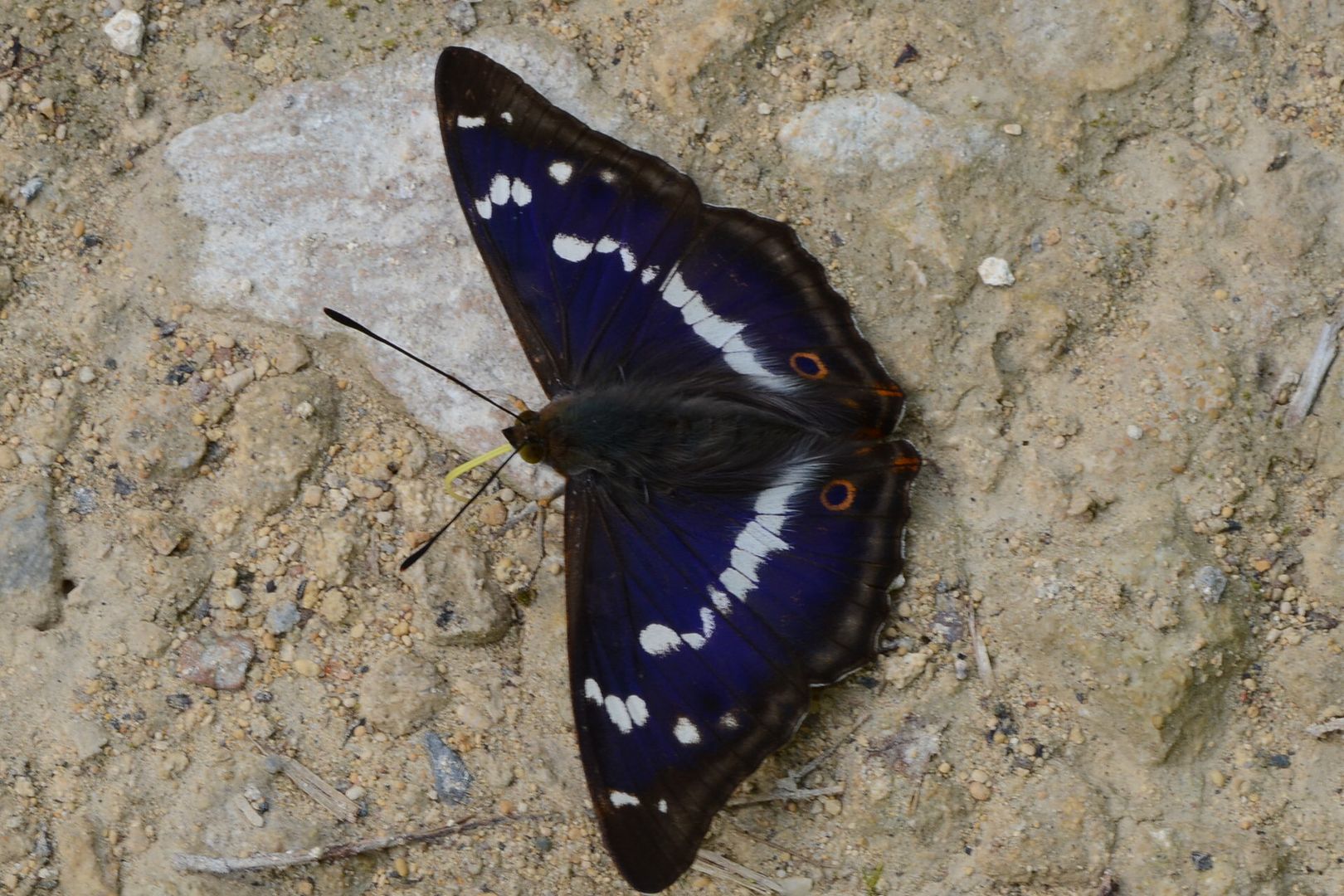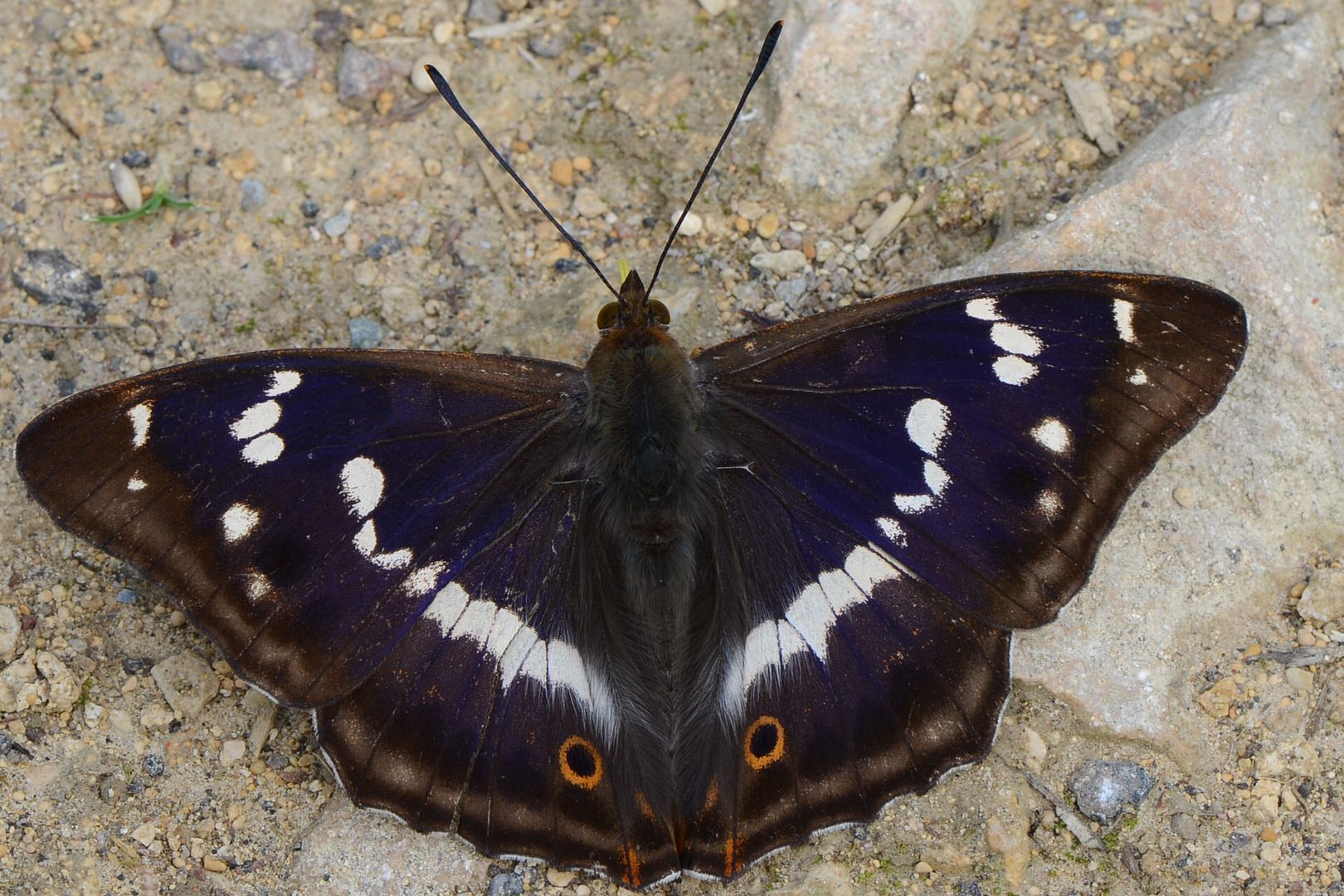Post by nomad on Jul 17, 2014 9:21:22 GMT -8
As has been mentioned here before, Britain has few butterflies compared to the rest of Europe, but we still has some spectacular ones and none more so than the Purple Emperor- Apatura iris. The Early British collectors went into raptures about this butterfly, not only because of its great beauty, but because it is a very hard species to secure , preferring to remain at the tops of oak trees. They referred to the males of A. iris as ' His Majesty ' or even the ' Sultan of Morocco' on account of the glorious purple iridescence of the males wings and considered the capture of this insect a ' great prize '. One early collector noticed that a male of A. iris was visiting a gruesome tally of weasels and stoats hung up on a fence by the local gamekeeper. Small dead animals were then used as bait and this method of attracting A. iris resulted in a morbid fascination by the Victorian collectors, who wondered why such a regal butterfly should not seek out the nectar of blossoms , but have such depraved habits. It is said, that by the early part of the 20th century, this method to lure iris down from its lofty haunts no longer worked. Perhaps because of the demise of the gamekeepers during the First World War and the resulting rise in Jay and Magpie populations saw too much predation. Had the butterfly become shyer and more uncommon or was it just that people did not now want to be seen waiting by a corpse in the middle of a woodland ride. Today in Britain, people still try to lure males of A. iris down from his lofty perch, but now only to photograph him. Old shrimp paste seems to work the best and down the males come, but usually only to ingest at damp places on woodland tracks or they will occasionally visit horse dung or dog and other animal poo.
An ex- African colonial official, Ian R. P. Heslop with two lepidopterist friends G.E. Hyde and R.E. Stockley produced a single volume on Apatura iris in 1964, which they called ' Notes and views on the Purple Emperor '. Heslop was also a big game hunter when he was stationed in Nigeria and once wrote that " nothing in all my sporting life ( shooting big animals) or collecting career, has ever given me so much joy as seeing of my first emperor safely in my net ". To Heslop, when he returned to live in Britain, the Purple Emperor became his passion and these butterflies became his big game. The authors of the Purple Emperor book were some of the last well known butterfly collectors in this country. By the 1970's the great demise and extinctions of many of the British butterfly populations through drastic habitat change, saw the virtual end of butterfly collecting in the U.K.
Habitat change was indeed responsible for many of the local extinctions of our woodland butterflies. We imagine only a change in woodland husbandry, such as a cession of coppicing. However, this is certainly not the only reason. During the 1960's and 1970's many private woodlands were sold by their owners to the government agency called the ' Forestry Commission ', whose only desire during this period was to make money out of their new acquisitions. They and other owners clear felled many grand old oak woods to sell the timber and replaced them with cash crops of planted conifers and beech plantations. Goat Sallow - Salix caprea, the foodplant of Apatura iris was now considered a weed and cut down where ever it was encountered. As the Sallow went so did the Purple Emperor. There was a serious decline of this magnificent species, it even disappeared from its stronghold of the Hampshire ' New Forest'. The Midland country ' Northamptonshire ' once had a number of historic localities for this species. Localities such as Ashton Wold and Barnwell Wold and others parts of old Rockinghamshire Forest, were once visited by collectors in search of specimens for their cabinets. By the 1950s the Purple Emperor had become a real rarity in Britain.
The gifted naturalist and countryside fiction writer Denys Watkins Pichford ( 1905-1990 ) who was known to the British public as 'BB' was saddened by the lost of so many butterfly species in his home county of Northamptonshire. In spite of extensive searches he had only seen the Purple Emperor in Northants, a few times. The woods and meadows of Barnwell and Aston Wold were by BB's day, already a thing of the past, with much habitat change. Barnwell Wold not only once supported A. iris, but also a colony of the rare Large Blue-Maculinea arion . When BB cycled to Barnwell Wold during the 1920s, the clipped short grass of the mid-19th century with its anthills and sheep, was by now long grass, rushes and scrub and by the 1950s he noted that the whole area was ploughed. Salcey Forest in Northants, a favourite haunt of BB was also a locality for A. iris. Salcey Forest was where BB first encountered the Purple Emperor and here he began his lifelong passion for this special butterfly. Salcey Forest was aerial sprayed for that pest, the Tortrix moth and the Purple Emperor quickly disappeared. Another favourite haunt of BB was an area of woodland he called in his books the ' Chase ', historically also part of ancient Rockingham Forest, which was not far from his Northants home. BB also knew these woodlands as Fermyn woods. The declining emperor population in these woodlands had also vanished. BB wrote many books for he was one of the countries top carp fishermen, a wildfowler and he was himself in his earlier years a collector of butterflies. Now he decided to act, he would now try to reintroduced his beloved butterfly, the Purple emperor in his home county in Fermyn woods.
While he was on holiday in Hampshire in Southern England during 1972 BB visited a woodland that was being clear felled and he searched the remaining Sallow bushes and collected a number of ova and reared the larvae on growing sallow bushes in his Northants garden and then released the adult butterflies in the nearby Chase'. There was a special ride in the woodland with a good quantity of Sallow and here the butterfly started to flourish. Every year for a long period he bred then released these butterflies along this woodland ride. One winter, he visited to see how his latest emperors were getting on and he was met with a disaster. All the Sallow bushes ( Salix) along the ride had been cut down inspite of the keeper promising to save them, the estate had hired contractors. BB was devastated, all his work of ten years lay in ruins. A lesser man would have given up, but not BB, he searched the cut Sallow trees along the ride and collected all the tiny over-wintering larvae he could find. With the keepers help he transferred them to another part of the wood where some Sallow bushes remained. BB continued to breed A. iris in his garden and released the adults in Fermyn woods right up to his last days. He was always writing to the Forestry Commission officers of Fermyn to save the foodplant Sallow bushes , sometimes it worked and sometimes it did not.
Today the area B.B knew as the Chase - Fermyn woods is managed by a more enlightened Forestry Commission who now help manage the woodlands for this species and because of BB 's - Denys Watkins Pichfords great work, the Purple emperor and their foodplant flourish here and today they are now the main British stronghold. As a fitting tribute to B.B work after a half century absence, A. iris once again flies where he first saw this species as a boy, Salcey Forest. Here an old hollow ancient oak gave B.B his idea for his best known work of fiction -Brendon Chase where three young lads run away from a hated aunt and live in the old tree and its forest like outlaws for almost a year. In Brendon Chase, there is the eccentric vicar who should be stalking the three young runaways in the forest, but whose real obsession is to capture a specimen of the Purple Emperor with his net he always carries with him. Surely the idea of this Northants Reverend collector came from B.B huddled over a winters fire when he was a young boy reading his copy of the F.O Morris book ' A History of British Butterflies ( 1853). Morris's encounter with the Purple Emperor at Ashton Wold was provided by the local rector of Polebrook, the well known collector William T. Bree.
In many localities in the U.K, numbers of Purple Emperors are down this year, the warm winter saw a lot of larvae predation. However, the Purple Emperors in BB's Chase - Fermyn woods have had a wonderful season. Fermyn woods lies among the gently rolling Northants countryside where attractive stone cottage villages nestle. Recently, I stayed for the weekend in one of these villages, nearby to BB's emperor woods to explore them to try to photograph this magnificent species. When I arrived on the Saturday, the main ride from the car park was packed with photographers and butterfly enthusiasts, all hoping for a treasured image or at least a sighting of the Purple Emperor. I moved off quickly deeper in the adjacent woodland where all was quiet save for the intense buzzing of numerous flies and the bird song. Infact, apart from a few walkers, I had the area to myself. It was a great thrill to walk along one of the gravel tracks and then suddenly have a male of A. iris circling around me and even landing on my person. Their glorious purple wings click as they closely speed pass you . When ingesting at damp spots they are often tame and they are a delight to photograph. Today, I had a suffused light which really brought out their purple colour in my images, the first time that I have ever managed such a feat. On other days their wings might appear with the purple showing on just one or two wings or it may just disappear altogether in very bright light and they then appear dark brown. The shade of their purple wings also varies with the time of day. To save the ache in my neck, later in the day I lay down on the edge of a grassy ride and watched the aerial disputes of the males as they chased each around the tops of the oaks. The female is rarely seen, she often spends the morning sitting, walking or mating around the top of an oak tree and then in the early afternoon, she descends to egg lay, flitting among the Sallow bushes. So it was a great surprise to find a female perched on some grass heads as I left these woodlands on the Sunday, a very fitting end to my visit here. BB, if he was alive today, would have been pleased with the comparative ease which we can find A. iris in Fermyn woods today, because for many years a sighting of this special butterfly was such a rare occurrence . Below are some of my favourite images of my time spent with A. iris, I hope you enjoy them.
A very interesting book on BB's - Denys Watkins Pitchford's work and study of the Purple Emperor and other butterflies by Bryan Holden has been published by Roseworld publications ( 2013 ) called BB's Butterflies.
Peter
An ex- African colonial official, Ian R. P. Heslop with two lepidopterist friends G.E. Hyde and R.E. Stockley produced a single volume on Apatura iris in 1964, which they called ' Notes and views on the Purple Emperor '. Heslop was also a big game hunter when he was stationed in Nigeria and once wrote that " nothing in all my sporting life ( shooting big animals) or collecting career, has ever given me so much joy as seeing of my first emperor safely in my net ". To Heslop, when he returned to live in Britain, the Purple Emperor became his passion and these butterflies became his big game. The authors of the Purple Emperor book were some of the last well known butterfly collectors in this country. By the 1970's the great demise and extinctions of many of the British butterfly populations through drastic habitat change, saw the virtual end of butterfly collecting in the U.K.
Habitat change was indeed responsible for many of the local extinctions of our woodland butterflies. We imagine only a change in woodland husbandry, such as a cession of coppicing. However, this is certainly not the only reason. During the 1960's and 1970's many private woodlands were sold by their owners to the government agency called the ' Forestry Commission ', whose only desire during this period was to make money out of their new acquisitions. They and other owners clear felled many grand old oak woods to sell the timber and replaced them with cash crops of planted conifers and beech plantations. Goat Sallow - Salix caprea, the foodplant of Apatura iris was now considered a weed and cut down where ever it was encountered. As the Sallow went so did the Purple Emperor. There was a serious decline of this magnificent species, it even disappeared from its stronghold of the Hampshire ' New Forest'. The Midland country ' Northamptonshire ' once had a number of historic localities for this species. Localities such as Ashton Wold and Barnwell Wold and others parts of old Rockinghamshire Forest, were once visited by collectors in search of specimens for their cabinets. By the 1950s the Purple Emperor had become a real rarity in Britain.
The gifted naturalist and countryside fiction writer Denys Watkins Pichford ( 1905-1990 ) who was known to the British public as 'BB' was saddened by the lost of so many butterfly species in his home county of Northamptonshire. In spite of extensive searches he had only seen the Purple Emperor in Northants, a few times. The woods and meadows of Barnwell and Aston Wold were by BB's day, already a thing of the past, with much habitat change. Barnwell Wold not only once supported A. iris, but also a colony of the rare Large Blue-Maculinea arion . When BB cycled to Barnwell Wold during the 1920s, the clipped short grass of the mid-19th century with its anthills and sheep, was by now long grass, rushes and scrub and by the 1950s he noted that the whole area was ploughed. Salcey Forest in Northants, a favourite haunt of BB was also a locality for A. iris. Salcey Forest was where BB first encountered the Purple Emperor and here he began his lifelong passion for this special butterfly. Salcey Forest was aerial sprayed for that pest, the Tortrix moth and the Purple Emperor quickly disappeared. Another favourite haunt of BB was an area of woodland he called in his books the ' Chase ', historically also part of ancient Rockingham Forest, which was not far from his Northants home. BB also knew these woodlands as Fermyn woods. The declining emperor population in these woodlands had also vanished. BB wrote many books for he was one of the countries top carp fishermen, a wildfowler and he was himself in his earlier years a collector of butterflies. Now he decided to act, he would now try to reintroduced his beloved butterfly, the Purple emperor in his home county in Fermyn woods.
While he was on holiday in Hampshire in Southern England during 1972 BB visited a woodland that was being clear felled and he searched the remaining Sallow bushes and collected a number of ova and reared the larvae on growing sallow bushes in his Northants garden and then released the adult butterflies in the nearby Chase'. There was a special ride in the woodland with a good quantity of Sallow and here the butterfly started to flourish. Every year for a long period he bred then released these butterflies along this woodland ride. One winter, he visited to see how his latest emperors were getting on and he was met with a disaster. All the Sallow bushes ( Salix) along the ride had been cut down inspite of the keeper promising to save them, the estate had hired contractors. BB was devastated, all his work of ten years lay in ruins. A lesser man would have given up, but not BB, he searched the cut Sallow trees along the ride and collected all the tiny over-wintering larvae he could find. With the keepers help he transferred them to another part of the wood where some Sallow bushes remained. BB continued to breed A. iris in his garden and released the adults in Fermyn woods right up to his last days. He was always writing to the Forestry Commission officers of Fermyn to save the foodplant Sallow bushes , sometimes it worked and sometimes it did not.
Today the area B.B knew as the Chase - Fermyn woods is managed by a more enlightened Forestry Commission who now help manage the woodlands for this species and because of BB 's - Denys Watkins Pichfords great work, the Purple emperor and their foodplant flourish here and today they are now the main British stronghold. As a fitting tribute to B.B work after a half century absence, A. iris once again flies where he first saw this species as a boy, Salcey Forest. Here an old hollow ancient oak gave B.B his idea for his best known work of fiction -Brendon Chase where three young lads run away from a hated aunt and live in the old tree and its forest like outlaws for almost a year. In Brendon Chase, there is the eccentric vicar who should be stalking the three young runaways in the forest, but whose real obsession is to capture a specimen of the Purple Emperor with his net he always carries with him. Surely the idea of this Northants Reverend collector came from B.B huddled over a winters fire when he was a young boy reading his copy of the F.O Morris book ' A History of British Butterflies ( 1853). Morris's encounter with the Purple Emperor at Ashton Wold was provided by the local rector of Polebrook, the well known collector William T. Bree.
In many localities in the U.K, numbers of Purple Emperors are down this year, the warm winter saw a lot of larvae predation. However, the Purple Emperors in BB's Chase - Fermyn woods have had a wonderful season. Fermyn woods lies among the gently rolling Northants countryside where attractive stone cottage villages nestle. Recently, I stayed for the weekend in one of these villages, nearby to BB's emperor woods to explore them to try to photograph this magnificent species. When I arrived on the Saturday, the main ride from the car park was packed with photographers and butterfly enthusiasts, all hoping for a treasured image or at least a sighting of the Purple Emperor. I moved off quickly deeper in the adjacent woodland where all was quiet save for the intense buzzing of numerous flies and the bird song. Infact, apart from a few walkers, I had the area to myself. It was a great thrill to walk along one of the gravel tracks and then suddenly have a male of A. iris circling around me and even landing on my person. Their glorious purple wings click as they closely speed pass you . When ingesting at damp spots they are often tame and they are a delight to photograph. Today, I had a suffused light which really brought out their purple colour in my images, the first time that I have ever managed such a feat. On other days their wings might appear with the purple showing on just one or two wings or it may just disappear altogether in very bright light and they then appear dark brown. The shade of their purple wings also varies with the time of day. To save the ache in my neck, later in the day I lay down on the edge of a grassy ride and watched the aerial disputes of the males as they chased each around the tops of the oaks. The female is rarely seen, she often spends the morning sitting, walking or mating around the top of an oak tree and then in the early afternoon, she descends to egg lay, flitting among the Sallow bushes. So it was a great surprise to find a female perched on some grass heads as I left these woodlands on the Sunday, a very fitting end to my visit here. BB, if he was alive today, would have been pleased with the comparative ease which we can find A. iris in Fermyn woods today, because for many years a sighting of this special butterfly was such a rare occurrence . Below are some of my favourite images of my time spent with A. iris, I hope you enjoy them.
A very interesting book on BB's - Denys Watkins Pitchford's work and study of the Purple Emperor and other butterflies by Bryan Holden has been published by Roseworld publications ( 2013 ) called BB's Butterflies.
Peter

